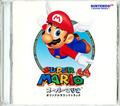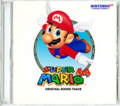Super Mario 64 Original Soundtrack: Difference between revisions
(No longer available, and unofficial) |
No edit summary |
||
| Line 6: | Line 6: | ||
|publisher=Pony Canyon, Inc., [[Nintendo]] | |publisher=Pony Canyon, Inc., [[Nintendo]] | ||
|released={{released|Japan|July 19, 1996|USA|November 1, 1996|Europe|1997}} | |released={{released|Japan|July 19, 1996|USA|November 1, 1996|Europe|1997}} | ||
|media=Compact | |media=Compact disc | ||
|track=36 | |track=36 | ||
|length=51:14 | |length=51:14 | ||
| Line 14: | Line 14: | ||
The '''''Super Mario 64 Original Soundtrack''''' is a video game album that was produced and copyrighted by [[Nintendo]] and published by {{wp|Pony Canyon}}. The album was released in Japan and North America in 1996 and Europe in 1997. The soundtrack has thirty-four tracks from [[Super Mario 64|the game with the same name]], as well as a voiceover intro from the title screen, which is performed by the star of the game, [[Charles Martinet]]; the final track is a bonus piano version of Piranha Plant's Lullaby performed by [[Koji Kondo]]. The Japanese release is also the first of ten soundtracks in the [[Nintendo 64 Sound Series]]. | The '''''Super Mario 64 Original Soundtrack''''' is a video game album that was produced and copyrighted by [[Nintendo]] and published by {{wp|Pony Canyon}}. The album was released in Japan and North America in 1996 and Europe in 1997. The soundtrack has thirty-four tracks from [[Super Mario 64|the game with the same name]], as well as a voiceover intro from the title screen, which is performed by the star of the game, [[Charles Martinet]]; the final track is a bonus piano version of Piranha Plant's Lullaby performed by [[Koji Kondo]]. The Japanese release is also the first of ten soundtracks in the [[Nintendo 64 Sound Series]]. | ||
==Track | The soundtrack is featured in ''[[Super Mario 3D All-Stars]]'' alongside the ''[[Super Mario Sunshine]]'' and ''[[Super Mario Galaxy]]'' [[Super Mario Galaxy: Original Soundtrack|soundtrack]]s, albeit with a slightly altered version of the Japanese cover used to represent it. | ||
==Track listing== | |||
#"It's a Me, [[Mario]]!" (Original title: "It's me, Mario!") (Voice: Charles Martinet) | #"It's a Me, [[Mario]]!" (Original title: "It's me, Mario!") (Voice: Charles Martinet) | ||
#Title Theme (used at the beginning of the game) | #Title Theme (used at the beginning of the game) | ||
| Line 51: | Line 53: | ||
#Staff Roll (used in the [[List of Super Mario 64 staff|ending credits]]) | #Staff Roll (used in the [[List of Super Mario 64 staff|ending credits]]) | ||
#Piranha Plant's Lullaby – Piano (Original title: Pakkun Flower's Lullaby) (soundtrack only song) | #Piranha Plant's Lullaby – Piano (Original title: Pakkun Flower's Lullaby) (soundtrack only song) | ||
==Gallery== | |||
<gallery> | |||
Soundtrack 64 JP-Super Mario 3D All-Stars.png|Japanese cover | |||
SM3DAS SM64 Soundtrack CD.png|English cover from ''Super Mario 3D All-Stars'', based on the original Japanese cover | |||
</gallery> | |||
{{Music}} | {{Music}} | ||
Revision as of 08:15, September 18, 2020
| It has been suggested that audio and/or video file(s) related to this article be uploaded. Please upload all related music, sound effects, voice clips, or any videos for this section. See the help page for information on how to get started. |
The Super Mario 64 Original Soundtrack is a video game album that was produced and copyrighted by Nintendo and published by Pony Canyon. The album was released in Japan and North America in 1996 and Europe in 1997. The soundtrack has thirty-four tracks from the game with the same name, as well as a voiceover intro from the title screen, which is performed by the star of the game, Charles Martinet; the final track is a bonus piano version of Piranha Plant's Lullaby performed by Koji Kondo. The Japanese release is also the first of ten soundtracks in the Nintendo 64 Sound Series.
The soundtrack is featured in Super Mario 3D All-Stars alongside the Super Mario Sunshine and Super Mario Galaxy soundtracks, albeit with a slightly altered version of the Japanese cover used to represent it.
Track listing
- "It's a Me, Mario!" (Original title: "It's me, Mario!") (Voice: Charles Martinet)
- Title Theme (used at the beginning of the game)
- Peach's Message (used when Peach reads her letter, as well as when collecting enough Stars to open a Star Door)
- Opening (used when Lakitu first appears)
- Super Mario 64 Main Theme (used in Bob-omb Battlefield, Whomp's Fortress, Tall, Tall Mountain, and Tiny-Huge Island)
- Slider (used in Rainbow Ride, Tick Tock Clock and in all Secret Slide areas)
- Inside the Castle Walls (Original title: Castle) (used inside Mushroom Castle)
- Looping Steps (used when the endless stairs are in use)
- Dire, Dire Docks (Original title: Water) (used in Jolly Roger Bay, Dire, Dire Docks and Secret Aquarium)
- Lethal Lava Land (Original title: Fire Bubble) (used in Lethal Lava Land and Shifting Sand Land)
- Snow Mountain (used in Cool, Cool Mountain and Snowman's Land)
- Haunted House (used in Big Boo's Haunt)
- Merry-Go-Round (used in Big Boo's Haunt on the merry-go-round)
- Cave Dungeon (main theme of Hazy Maze Cave and Wet-Dry World; also heard in the Cavern of the Metal Cap, inside the pyramid of Shifting Sand Land, the igloo of Snowman's Land, and Wiggler's cave in Tiny-Huge Island); a cover version of the Super Mario Bros. Underground theme
- Piranha Plant's Lullaby (Original title: Pakkun Flower's Lullaby) (used in Whomp's Fortress when by a Piranha Plant)
- Powerful Mario (used when wearing a Wing Cap or Vanish Cap)
- Metallic Mario (used when wearing a Metal Cap)
- File Select (used at the "file select" screen)
- Correct Solution (used when figuring out a problem in any level)
- Toad's Message (Original title: Kinopio's Message) (used when talking to Toad)
- Power Star (used when freeing a Power Star)
- Race Fanfare (used when any type of race starts)
- Star Catch Fanfare (used after Mario collects a Power Star)
- Game Start (used at the beginning of every main course)
- Course Clear (used at the end of any main course's level)
- Game Over (used after Mario runs out of lives)
- Stage Boss (used in only four of the stage boss battles in the game: King Bob-omb in Bob-omb Battlefield, the Whomp King in Whomp's Fortress, Eyerok in Shifting Sand Land, and Wiggler in Tiny-Huge Island)
- Koopa's Message (used at the beginning of the game when the player enters the castle)
- Koopa's Road (used in all Bowser courses)
- Koopa's Theme (used in Dark World and Fire Sea Bowser battles)
- Koopa Clear (used after defeating Bowser and claiming his key)
- Ultimate Koopa (used in the final Bowser battle)
- Ultimate Koopa Clear (used after clearing the final Bowser battle)
- Ending Demo (used when Mario is freeing Peach from the castle walls)
- Staff Roll (used in the ending credits)
- Piranha Plant's Lullaby – Piano (Original title: Pakkun Flower's Lullaby) (soundtrack only song)

